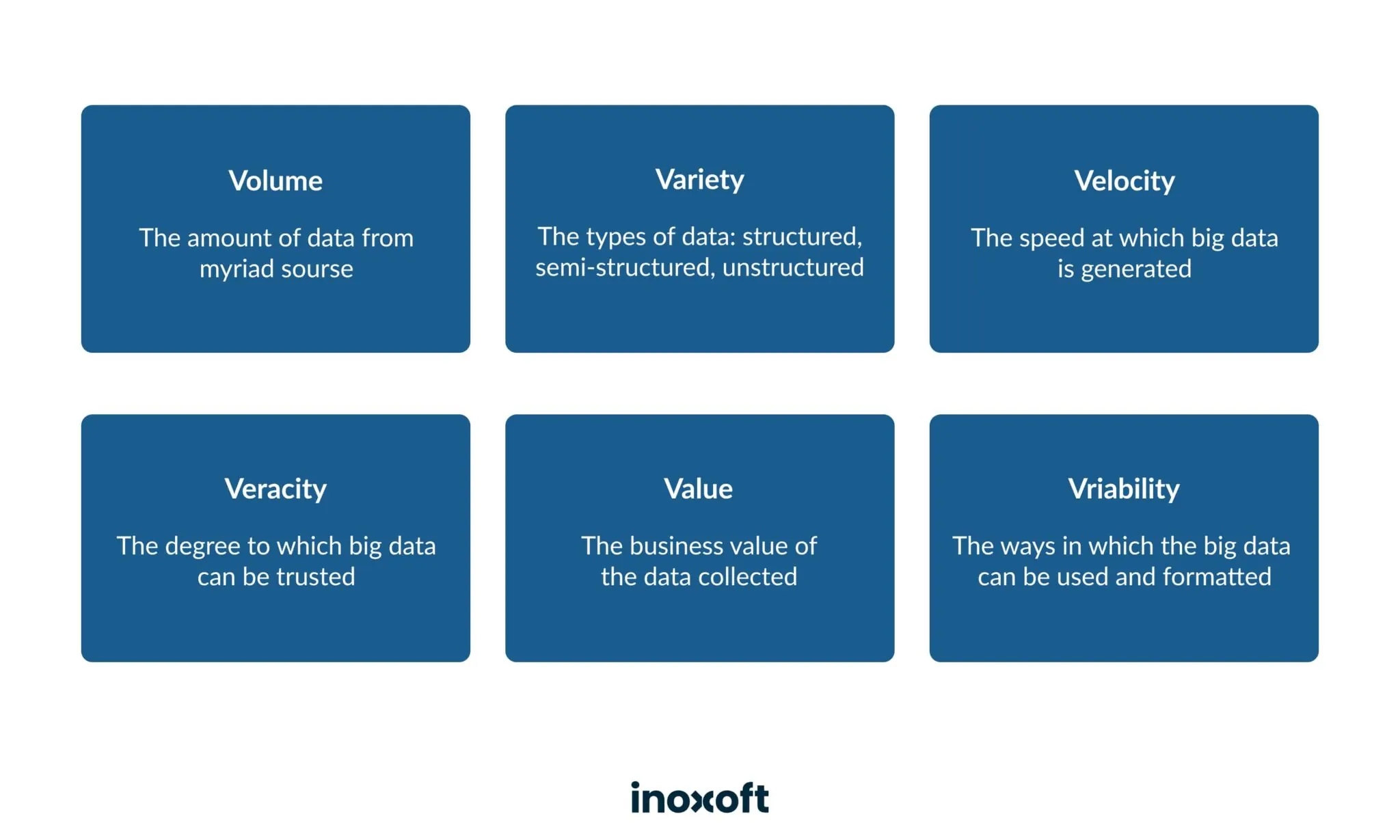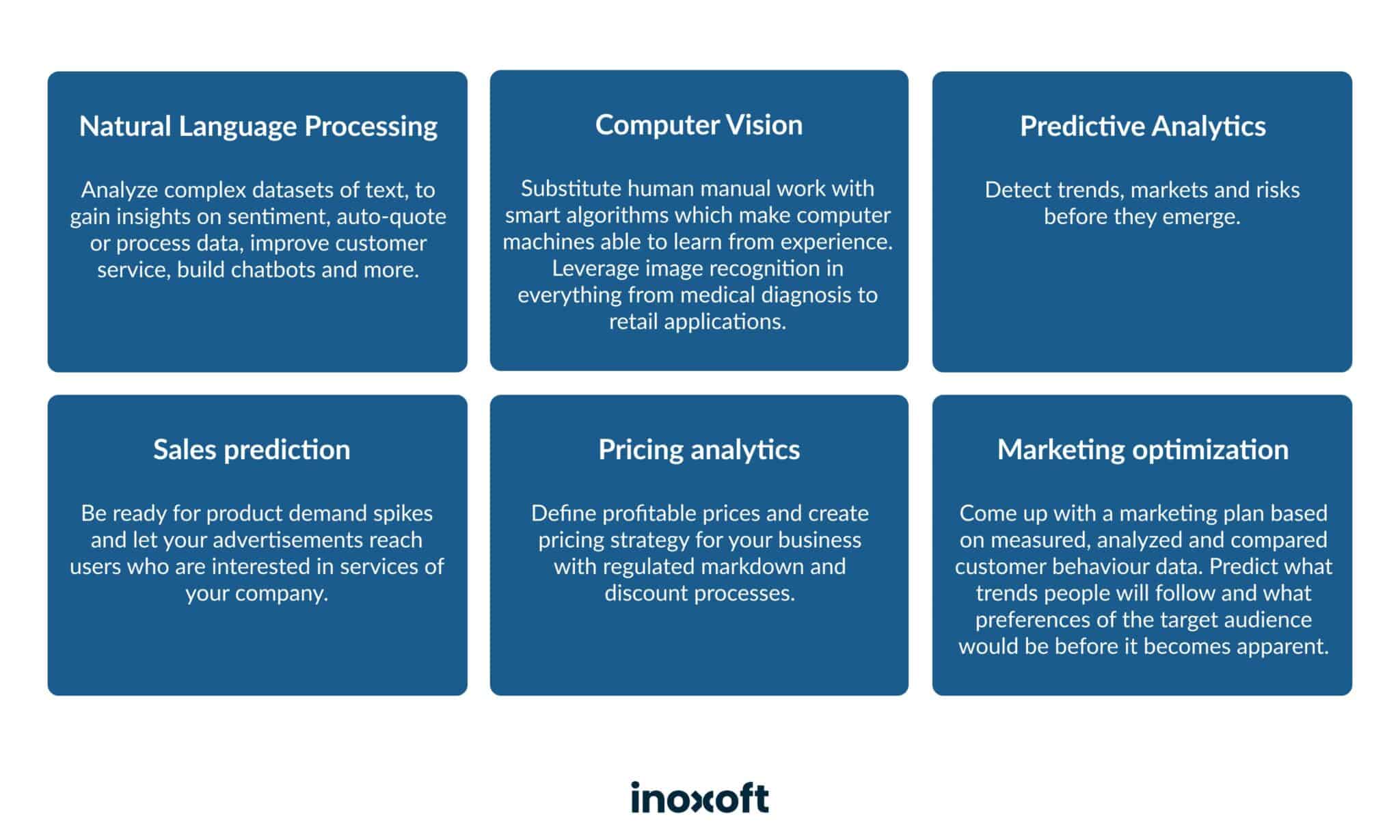Lately, everything around us has become digitized. Every day, we send messages, sign docs online, share videos, and music. And, favorite movies and speak to each other using audio messages. All this sent and received information is called Big Data.
The main questions are: "Can Big Data really show future consumer buying patterns? Can it predict and prevent diseases or business failure? Can it produce an accurate focus for any business in any industry? Or, maybe, it is all just a big hype? Maybe, the things Big data can do are being overrated?" That’s what this article is about to discuss.
Using AI-driven analytics applications, humanity is pretty capable of processing these huge piles of information. Executive Chairman at Google, Eric Schmidt states that there were more than 5 exabytes created between the dawn of civilization through 2003, but that much information is created every two days.
With such extreme growth, it is no wonder experts speak about AI and Big Data hype. But are their words reasonable? Have you ever wondered or thought about the possibility of Big Data hype? Machine learning hype? Deep learning hype? Artificial Intelligence hype? Are they really that impactful and can change the world? Or, is Machine Learning overhyped? Is Data Science overrated? Let’s explore!
- What are AI and Big Data Hype?
- The Big Data criticism includes:
- Common myths about Big Data and AI
- 1. Big Data can predict future events
- 2. Machines can replace humans
- 3. Big Data cannot be easily handled
- 4. Big Data is only for enterprise-level companies
- 5. Big Data equals big budget, big teams, and big platforms
- 6. Big Data is a solution for everything
- 7. The more data you have the better
- 8. Big Data increases business ROI
- The Best Big Data Industry Solutions of Today
- Amazon
- Capital One (Bank)
- Netflix
- Starbucks
- American Express
- Next Big Sound
- T-Mobile
- Miniclip
- Dig Data Ideas for Startups
- CRM service
- Digital marketing service
- Big dating website
- Data mining consultancy service
- Fintech service
- Scientific computing service
- Data analytics educational channel
- Online research service
- How Is Big Data Revolutionizing The Current Age?
- Consider Inoxoft Your Trusted Big Data Partner
- Final thoughts
What are AI and Big Data Hype?
All the data, that currently exists in the world and comes from many different sources, consists of 6 Vs:
Typically, everything which is new to the world is taken in with caution. Big Data and AI are relatively new technologies that disrupt industries. For example, Big Data in Education, and Big Data Analytics in Finance. Or, there are benefits of Big Data in Healthcare.
The Big Data industry solutions’ potential is still not researched to its full extent. Some of the scientists say that Big Data analytics and AI are changing our world outlook for the better. Yet, there are also skeptics that believe these technologies are overhyped. For instance, Berkley’s University Machine Learning expert, Michael Jordan, says that there is a big potential in Big Data and we will see it soon.
However, Gartner analysts believe in AI hype. For this reason, they have left it out from their Emerging Technologies Hype Cycle for about 6 years now. And it became known as the Big Data hype cycle or Artificial Intelligence hype cycle. That’s why everyone’s been talking about Big Data in Gartner’s media light.
The Big Data criticism includes:
Inaccurate decision-making
Being constantly improving in its predictions with the help of algorithms, Big Data cannot be entirely relied upon. Especially, when it comes to critical decision-making. Why? Because it has defects and is still not perfect. Gartner Research made a clear estimate that Big Data projects would fail up to 60% till 2017. And, in 2017, Gartner analysts spoke about 85% of failures ahead. And again, Gartner states that in 2022 only 22% of Big Data and Artificial Intelligence solutions will impact business growth.
More data can bring more value
Here, the hype is in the fact that, perhaps, it is not possible to extract more value from Big Data by analyzing huge volumes of it. Especially if they are raw and unstructured. And, the data is not filtered enough. It would be beneficial only to assess smaller amounts of it dedicated to a certain focus. AI, Machine Learning, Deep Learning, and Data Analytics still require solid data management and new approaches.
You may be swamped with data, but you’re not swamped with relevant data. Even in a huge database, there is often only a small amount of it that is relevant. – Michael Jordan, Berkeley Research
No universal Big Data Analytics model
For the convenience of use, it would be best to have a model that could be applicable to everything and everywhere. But, basically, that’s impossible from now on. You cannot repeat the data you already have and analyze it again and again. It can be untrustworthy and too complex.
Today, the world’s Big Data market is predicted to grow up to $103 billion by 2027. That’s even more than double its market size in 2018. This year, the leading country with 51% of Big Data and BDA market share is the United States. Globally, the spending for BDA may reach $216 billion by the end of 2021. And the majority of the spendings will be in the IT sector. In the software development industry, lots of apps become AI and Big Data-driven.
Common myths about Big Data and AI
1. Big Data can predict future events
Among the most common Big Data myths, you can find the one about Big Data predicting the future. Of course, it can give relevant future insights. But, you will need to input past events and answer some basic questions. Algorithms need to work with the data that already exists to measure a theoretic event. And, their output cannot be considered as the ultimate truth. Especially, in the cases when humans train the models. Of course, ML models need data, algorithms, hardware, and data analysts. And, the latter tend to make mistakes.
2. Machines can replace humans
Predictive analytics in Big Data gained much attention and a belief that algorithms can replace the human workforce. Mainly, because some of the predictions were useful and preventive. But, this thought is considered the myth of Artificial Intelligence. It is wrong to think that algorithms can be made up themselves. And, that there is no human to analyze them. Only we, humans, are creative and can provide valuable critical reasoning. Machines are still far from that.
3. Big Data cannot be easily handled
So far, humanity has generated data from all the images, videos, audios, and documents all around the world. These are huge piles and piles of data. And, to handle it the right way, extracting value, and processing of Big Data should be done automatically. Big Data analytics has different tools that help automate this process. And, people tend to think these tools are hard to get used to. But, it’s another one among the AI myths. In order to get to know something, it is vital to get expert help and learn. Significant things like Big Data are harder to understand, but it is not entirely impossible. Make some efforts in this direction.
4. Big Data is only for enterprise-level companies
One of the complete myths about Big Data and AI is that it is only for an enterprise. Small companies can use Big Data to analyze smaller amounts of information. Also, they can use it in a specific area of focus. But the very data analysis stays the same. You need to be specifically equipped to carry out day-to-day operations. In this case, small businesses just have to personalize the approach.
5. Big Data equals big budget, big teams, and big platforms
You don’t have to have a big budget, gather big teams, and have big platforms for operations to engage in Big Data analytics. All you have to do is establish a smart approach. How? You should have the right experts in the field. Or reskill the existing ones. Learn the Data Science programming languages. The other option is to hire data scientists. Or outsource them.
Also, create a Big Data business strategy with all the potential goals you’d like to fulfill. Maybe, Big Data focus will require a little investment from the start. But, eventually, you’ll get the payback sooner than you expected. Big Data is extremely popular these days and can give an abundance of insights to businesses. So, implementing it wouldn’t be the wrong choice.
6. Big Data is a solution for everything
Big Data is raw data. It requires to be processed and refined to extract any value out of it. To achieve the desired value any business has to be skilled and understand the difference between Data Science and Big Data analytics. What’s more, Big Data can become a solution for everything only if the business has data scientists, analysts, support teams, and business managers. All of these people should have the right skills and experience.
7. The more data you have the better
Adhering to more data is not always a smart decision to make. Why? If this data is structured and clean, it’s ok. But if it is raw and the model will not give out the right and accurate prediction? More data always triggers greater risks. Especially, in case your models aren’t reviewed from time to time. Data features tend to change over time, and so should the algorithms.
8. Big Data increases business ROI
Among the Artificial Intelligence myths of today, you can also hear that Big Data will increase the ROI of your business. It is not always possible to receive the expected results with the help of technology. There are external factors that will impact analytical predictions.
The Best Big Data Industry Solutions of Today
Despite the debates and every myth surrounding Big Data, some of the most popular Big Data solutions could make a positive impact in the industry afterward. The 8 top Big Data solutions include:
Amazon
Companies like Amazon have access to a vast field of customer personal information. For example, names, dates, addresses, phone numbers, orders, payments, etc. So, this is the type of information the company giant uses to improve advertising. And, to improve customer relations. How exactly does it work? Big Data gathered about a potential customer is processed and analyzed to understand what type of information is the most relevant to every particular customer. And, what concerns customer relations, Amazon’s help desk already knows some of the information about its customers. So, it allows a support operator to answer right away and resolve customer solutions almost immediately.
Capital One (Bank)
The fintech institution uses Big Data to get to know their customers better. This way the bank can send extremely attractive offers personalized for every user of its services. What does it analyze to lead such a marketing strategy? Simple as that – user demographics and spending habits. This allows the bank to produce better marketing strategies and services for its loyal customers.
Netflix
Being an entertainment provision platform, Netflix gathers insights about its customers’ viewing habits. So, the company targets audiences to offer subscription or purchase services to certain films. And, Netflix knows these groups of people will surely buy their services. How? Due to obtaining information about customers’ preferences, movies they have watched, and their ability to pay for movies or monthly packages. And the data gathered and analyzed is all around the globe. Having the opportunity to offer what users like makes Netflix the top movie streaming platform.
Starbucks
Starbucks uses predictions made by algorithms. They use Big Data to analyze whether the new location of their physical business will be a success. All the company takes into account is geolocation, traffic, demographics in this location, and customer behavior. So, the estimation of the territory and potential buyers allows the opening of three coffee shops in a row. Starbucks always chooses the location, which will bring more revenue and has the biggest success rate via Big Data predictions. And, there has been no mistake so far. All Starbucks’ coffee shops are being extra popular among visitors and loyal customers.
American Express
The multinational payment and services company utilizes Big Data to be aware of consumer behavior in the future. So, it analyses this behavior in detail and predicts what it’s going to be like per some period of time. What does American Express analyze? Mainly, the history of transactions. The company applies predictive modeling with 100+ variables at its stake. They also call it business intelligence reporting. The forecasts American Express gets are quite accurate and show what is the percentage of customer loyalty and the churn rate. In Australia, the company used Big Data analytics to such an extent that they already know that 24% of people will close their accounts for up to four months.
Next Big Sound
Next Big Sound (NBS) is a music analytics company. It aims at providing the most accurate music choices for its users. So, they analyze the following sources to get any music insights:
- Streams in Spotify
- Sales in iTunes
- Pays in SoundCloud
- Likes in Facebook
- Certain page views in Wikipedia
- Like hits in YouTube
- Particular mentions in Twitter (X)
Besides the next top music lists, NBS also provides information on which social media will be more popular, TV appearances, and their overall impact on music. And, everything related to music, which allows producing a digital output of competitive musicians on the market. To ensure good collaborations with the world’s brands, e.g. Pepsi, they create two billboard chart trends based on their gathered data. This data is up-to-date and allows brands to find musicians who will promote the brand, do some marketing campaigns and become brand ambassadors.
T-Mobile
The T-mobile uses internet information of customer relations and billing, social media usage, and predicts possible customer fluctuations. The data analyzing tool integrations were carried out across all the IT systems on T-mobile. The company needs such data about customer interactions and transactions to decrease the customer churn rate in half.
Miniclip
Miniclip, a digital game developer, publisher, and distributor that also uses Big Data tools to improve user experience. Games should be a profitable business and to make it so, Miniclip supports its business by growing and prioritizing customer retention. Successful products and their features are being measured via Big Data reports, analyses, experimentations, and Machine Learning modeling. This allows the company to enhance and produce better features in the future. And, also, rethink the features that users have little interest in. By monitoring customers’ behavior, Miniclip makes their business growth natural and produces efficient games.
Dig Data Ideas for Startups
CRM service
A CRM system (Customer Relationship Management) is widely used nowadays by many companies to strategically analyze customers and their interactions with products or services. The analysis is based, of course, on customer data.
Having a CRM is a good input into future business growth. What can it exactly provide for a business?
- Improve ‘business – customer relationship
- Give extra insights into customer retention processes
- Help decrease the sales growth
Launching a CRM startup will make it possible for you to extract valuable customer data within a company, and automate company processes via AI-driven decisions. Also, as a result, this will improve customer relationships with any company.
Digital marketing service
What business tries to scale today without a marketing strategy onboard? It is a big and helpful system of channels, which allows brand promotion, online advertisements, and many more marketing tools to make customers aware of the business and its services. And, the best way to market your company into the world is to use AI and Data Science. If you choose to launch your Big Data startup in digital marketing, there is a vast field of services you can provide for businesses. Give it a try.
Big dating website
To make a dating website, you need to understand what is your audience, what user needs this website should cover, and whether it will be open-source. Why is it important? Because open-source code can be managed and adjusted to your customers 100%. Using AI here is the best option. The dating website will use this technology to ensure the best features on the platform, accomplishment of exquisite user needs, and give out them the best-match results.
Data mining consultancy service
Every company has volumes of unstructured and raw data. And, they would love this data to be structured and work for them. So, you can easily start a data mining consulting company. All you need is a data analyst and some good automated tools for data analysis. You can extract valuable data, structure it, and direct it into the right flow to get as much value as possible. Then, you will be able to consult your clients as to their business growth in the future. Also, you will be able to participate in company data management processes, strategic meetings, and so on. The key to analyzing data is power these days.
Fintech service
Today, almost every financial institution uses AI in its fintech services. Banks, investment agencies, insurance firms, credit card agencies, stock brokerages, companies providing accountancy, consumer finance, investment funds, and even individual managers revolve around Big Data and require it to be analyzed. So, engaging in this field and starting a fintech service is quite profitable. Your clients will be likely to need data science to grow and prosper. And, you can be the one, who knows how to help them.
Scientific computing service
Using mathematical models and ML simulations you can initiate a startup that solves all the world’s major business problems. How? By using a high-performance computer and solving complex issues via technology. It would be best if you are tech-savvy and have experience in Big data services, if not – hire someone skilled. There are companies in the world that need major solutions to make their businesses profitable. And you can be the one offering them major solutions at cost.
Data analytics educational channel
What if you are a Dig Data Analytics lover and you want to share your knowledge with someone else? Start a YouTube channel, open up online courses, make a video, audio, visual, or written material helpful to gain Big Data insights. You can be as competitive on the market as you only wish to be. Now, as Big Data is gaining momentum, it is quite necessary to transmit your knowledge. And, if you can do it better than others – it’s great. Also, you can monetize your channels and be quite popular.
Online research service
Using AI, Big Data, Predictive Data analytics it is possible to build a data research center (a website) like Statista. You will be able to gather worldwide data and make sector-relevant and time-relevant predictions. Any business would want to use these services in their business strategy creation or making business continuity plans.
How Is Big Data Revolutionizing The Current Age?
Big Data is reshaping how industries operate, encompassing the technology, tools, and methods employed in the collection. It analyzes immense volumes of data, spanning structured, unstructured, and semi-structured formats.
One of the biggest impacts of Big Data lies in its ability to unlock unprecedented insights from vast and complex datasets – that’s how it reshapes decision-making processes. Companies can gather and analyze massive amounts of data from diverse sources, including customer interactions, preferences and market demands. For example, corporate giants Netflix and Spotify use data to recommend personalized content to their users to enhance customer satisfaction and loyalty.
The fact that 90% of the world’s existing data has been generated within two years proves a clear imperative for technology capable of handling the immense data flows, managing these datasets effectively, and harnessing their potential for beneficial purposes. As technology advances, we can expect even more sophisticated tools and techniques to open up the potential of Big Data for the betterment of businesses, society, and beyond. It’s an exciting time for data-driven decision-making since the possibilities seem infinite. But the future is yet to come, so we’ll see how that one goes.
Consider Inoxoft Your Trusted Big Data Partner
Inoxoft is a Big Data development company that can turn your business idea into reality! We provide Big Data development services. For example,
- Natural Language Processing (NLP)
- Computer Vision
- Predictive Analytics
- Sales Prediction
- Pricing Analytics
- Marketing Optimization
Each of our AI software developers organizes and structures raw data coming from external sources as well as your internal data. We will transform it into necessary formats ready for analysis per your requirements and convenience. For example, check out our Success Stories to get more insight into what we can do for you.
If you’d like to receive Data Science and Big Data Analytics Services, including:
- Data collecting
- Data filtering
- Structuring
- Setting correlations between data sets
- Conducting further analysis
- Receiving insights
- Making data-driven decisions
Contact us right away and you will receive a free consultation! We are the market-leading provider of Data Science solutions. Our team can gather all the data of your potential audiences and produce the most efficient Machine Learning algorithms. There’s no hype about AI or Big Data when it comes to us!
Final thoughts
Bid data may be considered hype by some skeptics, but it is a real thing these days. The importance of being able to process information and get valuable prediction patterns is amazing. So, if you want to make your business grow, it is worth investing in Big Data solutions. Whether you are a small business or a big one, a warehouse or a digital website, or even a bank – predictive analytics can and will make your business grow. The way customers behave tells a lot of information about your products and services and can predict customer churn rates, retention rates, and overall popularity of your doings. Don’t miss out on the opportunity to scale with Big Data and predictive analytics.
Frequently Asked Questions
How do misconceptions about Big Data and AI impact businesses today?
Businesses may overspend on technologies without a clear understanding of their specific needs, expecting immediate returns. Unrealistic expectations can result in disappointment when anticipated outcomes are not achieved.
Moreover, misunderstanding the capabilities and limitations of these technologies may lead to suboptimal decision-making and hinder the potential benefits of Big Data and AI.
How can startups leverage Big Data ideas to enhance their services and products?
They can use analytics for informed choices, like personalize based on behavior, forecast trends, optimize resources, cut costs, invest for flexible growth, ensure robust protection, and explore revenue from data.
Is Big Data exclusively reserved for large enterprise-level companies?
No, the concept of Big Data refers to the processing and analysis of large and complex datasets, which can be relevant for businesses of various sizes. Small and medium-sized enterprises can also gain insights, improve decision-making, and enhance overall efficiency — the key is to tailor the approach to the specific needs and scale of the business.


















